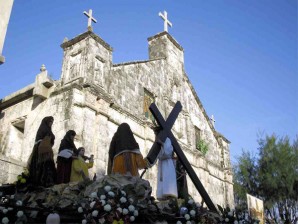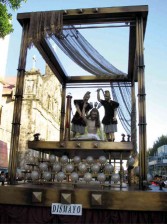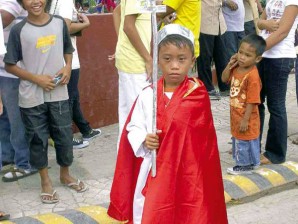Holy Week procession showcases tradition, faith of Bantayan folk

A “CAROZZA” passes in front of the ancient stone church of Bantayan town, Bantayan Island, Cebu. PHOTO BY Trizer D. Mansueto
BANTAYAN ISLAND, Cebu—For several decades now, the mere mention of Semana Santa (Holy Week) on Bantayan Island in northern Cebu conjures up images of a fiesta.
This has been the general impression of many people about the island’s celebration of the passion and death of Jesus. But to the Bantayanon, this is the way they celebrate Lent.
Perhaps because of the town’s fiesta atmosphere and the practice of eating meat on days of fasting and abstinence, people have come to conclude that it is indeed a fiesta.
Bantayan town, one of the three towns on the island, celebrates its fiesta on June 29, in honor of Saints Peter and Paul.
But the fiesta atmosphere is just the secondary reason people go to Bantayan. Neither do they come here to escape from the faithful observance of Holy Week rites.
Article continues after this advertisementPeople flock to Bantayan to witness the town’s grandiose processions. The big fire that razed almost the entire Poblacion area on Holy Week of 1973 has not stopped the Bantayanons from parading their images around the town because this has been their practice for centuries.
Article continues after this advertisementWhile some houses were burning, devout Bantayanon families who had “pasos (Lenten tableaux)” saved their heirloom processional images first before other pieces of property.

ONE OF BANTAYAN town’s processional tableau showing Jesus being whipped by Roman soldiers. PHOTO BY Trizer D. Mansueto
Two of these images had to be thrown to the sea so that they would not be gobbled up by the fire. Happily, none of the precious images was burned.
From only a handful of “carrozas,” new ones were added in recent years. Now, at least 16 carrozas are brought out on Maundy Thursday and 17 on Good Friday.
Some of the original processional images now in the hands of some families used to belong to the church. These images were listed by former parish priest Fr. Leoncio Aguilar in the June 1887 inventory which can still be perused in the parish’s archives.
Works of art
Some of the images found in the 1887 inventory apparently came from Spain and brought to the island by past Spanish priests.
Most of the latter images, commissioned by rich families as a form of “panaad (vow),” were sculpted by local artisans like Severino “Ma Binoy” Carabio, who executed the dramatic piece on the deposition of the body of Jesus from the cross, and Antonio Tinga, who created the processional piece that shows Jesus being stripped off his garments.
Each carozza is a work of art. Families, who own these carrozas, shell out huge amounts of money each year to make them beautiful.
One rich Bantayan resident willed that the returns from a piece of land he owned, which encompassed practically one whole barangay, was to be given to the church to fund the paso of Bantayan’s celebrated image of the Santo Entierro each Semana Santa.
Bantayan’s procession showcases the tradition and faith of the Bantayanons.
Fishermen from Bantayan and nearby islets as well as those from other provinces like Masbate and Leyte congregate in Bantayan town to witness the processions.
These fishermen stop fishing to offer thanksgiving for the blessings received and to observe some fishing rituals done only during Holy Week.
Most of these fishermen also come to get the flowers, particularly from the carroza of the Santo Entierro to be used as “tuob (incense)” for their fishing gears which they believe will give them luck.
The fishermen also bring their children who they dress in various saints’ garb. These children are called “saaran (one who is vowed)” and may don the garb of the saint who gave them a favor, usually involving a healing.
One will never miss the saint whom the parents of a saaran asked a favor from.
It is easy to recognize the Virgin of Sorrows, or modern saints like St. Therese of Lisieux for girls. San Pedro Apostol, on the other hand, is easily recognizable with his papal crosier and the keys he is holding.
San Vicente Ferrer and San Antonio de Padua are also popular for boys. Some of the boy saraans even sport a peso-sized tonsure on their heads.
Special dispensation
Although it has been the tradition of some Bantayanons to eat meat during Holy Week, not all Bantayanons practice this.
For over a century, some Bantayanons have been eating meat on these days apparently because at some point in time, they have been exempted from this practice by Church authorities in Spain.
In the year 2000, while doing a research on the history of the parish of Bantayan, this correspondent stumbled upon a document tucked in one of the parish’s ancient ecclesiastical books.
The document, now referred to as an indult, is a special dispensation for the consumption of meat on Lent.
The document was apparently given to the people of the island because superstitious fishermen would refuse to launch to the sea during Holy Week for fear of earning God’s wrath.
In the end, islanders had nothing to eat but meat.
The indult was issued to Fr. Doroteo Andrada del Rosario, the parish priest of Bantayan in 1840, following the stringent rules issued by the Office of the Inquisition in Madrid.
With the help of Regalado Trota Jose, University of Santo Tomas professor and ecclesiastical historian, it has been found that the indult was authentic but that it had a prescription.
Are Bantayanons still allowed to eat meat on Lent?
That is the question which perhaps only the Vatican can answer given the fact that the practice has become a tradition for over a century now.
But then with so many visitors pouring into the island these days, it is practically impossible for ordinary folk to follow the rules on abstinence stringently with rising costs of seafood due to high demand.
Despite this, there are families who endeavor to refrain from eating meat, in deference to their faith.
